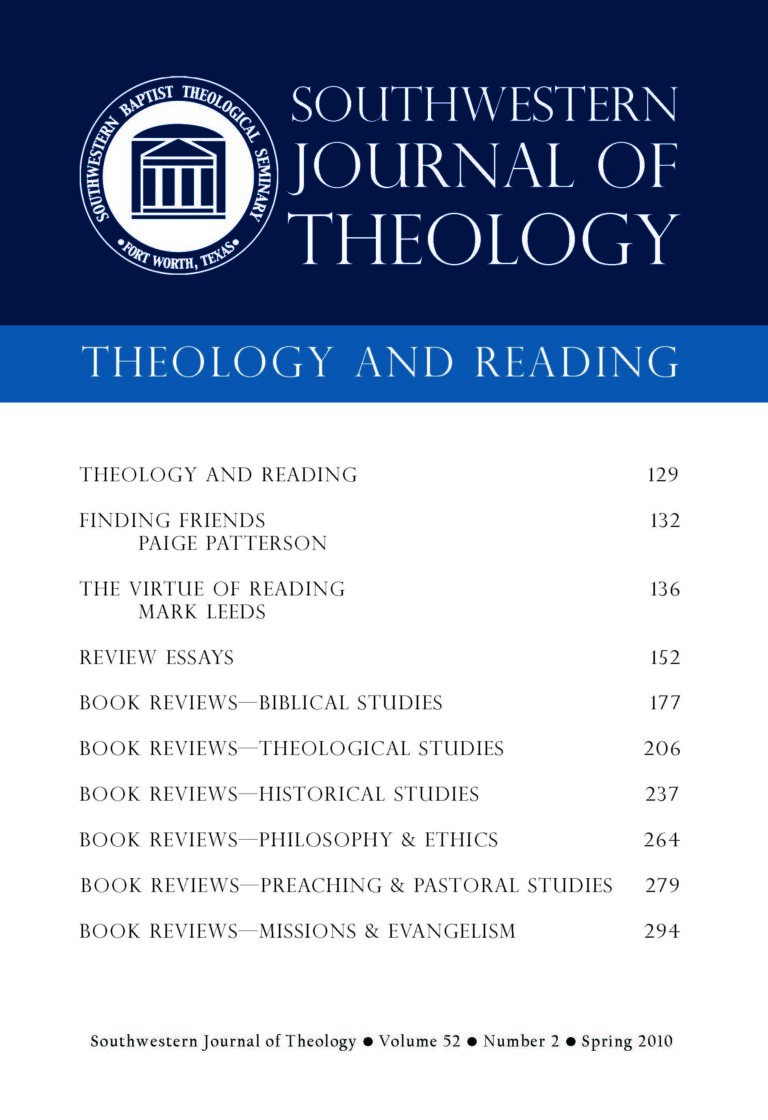
Theology and Reading
Southwestern Journal of Theology
Volume 52, No. 2 – Spring 2010
Managing Editor: Malcolm B. Yarnell III
By Eckhard J. Schnabel. Downers Grove: InterVarsity Press, 2008. 518 pages. Softcover, $32.00.
A quick glance at the reviews on the back of Schnabel’s book, Paul the Missionary, gives an early indication of the intended audience. It is described as “an invaluable foundation,” a useful “textbook” for the missions classroom and current missionary practitioners. Thus, unlike Schnabel’s meticulous two-volume work, Early Christian Mission, this book manages its subject in a more introductory fashion, yet with a specific purpose: to challenge pastors and missionaries to read Paul more closely and then evaluate their own goals and methods accordingly (14). This purpose determines the structure behind Schnabel’s book. Before looking critically at modern missionary methodologies, before even attempting a synthesis of Paul’s goals and methods, Schnabel observes Paul’s missionary career, Paul’s description of his own task, and the central aspects of Paul’s message.
In chapter 1, Schnabel begins with brief summaries of Paul’s cultural background, his conversion, and his relationship with the Jerusalem apostles before conducting a survey of his missionary activities. Schnabel’s approach in this chapter is unique in two ways. First, his description of Paul’s ministry and travels is an integration of the content found in Acts, Paul’s letters, and early church tradition. This is a refreshing contrast to works that see Paul’s letters as the only reliable source of information. Second, Schnabel avoids the traditional division of Paul’s work into the three journeys described in Acts. Instead, he divides Paul’s efforts into fifteen smaller “periods” that include his early work in Jerusalem and his later work in Spain and Crete. The result is a panoramic scope of Paul’s entire life’s work.
In chapter 2, Schnabel turns almost exclusively to Paul’s letters with a focus on key passages where Paul describes the nature of his mission. For example, in Galatians 1–2, Paul provides his understanding of his call to missionary work; in 1 Thessalonians 1:4–10, he presents a succinct summary of his message; in 1 Thessalonians 2:2–8, he remarks on the importance of the manner of his proclamation; and in 1 Corinthians 3:5–15, Paul describes his goal as the establishment of churches, and so on.
At first glance, Schnabel’s description of Paul’s message in chapter 3 appears to be simply the re-stating of material found in Early Christian Mission vol. 2, since the sub-headings are almost identical. However, here Schnabel’s approach differs as he focuses primarily on Luke’s recordings of Paul’s sermons in Acts for the content of his preaching to different audiences. Schnabel’s analysis shows that the content of Paul’s message has specific relevance both for Jewish and Gentile audiences, and that the gospel of salvation through Christ confronts the cultural norms of its converts.
With chapter 4, Schnabel turns from the descriptive task to synthetic analysis, seeking to describe the goals of Paul’s missionary activity based on his previous observations. Paul preaches the gospel, both to Jews and Gentiles, to convert individuals. He further seeks to establish these converts into communities of faith and instruct them in church life and outreach. Finally, Paul also trains new missionaries for service. Schnabel’s approach here incorporates some interesting word studies. While considering the goal of Paul’s preaching, Schnabel observes the usage and meaning of εὐαγγελιζώ; for Paul’s intended audience, the use of the term ἐθνόϛ; for the importance of forming communities, ἐκκλησία; etc. Yet, this section also contains one of the most detailed arguments against Reisner’s theory for Paul’s geographical movements. Schnabel asserts that Paul’s journeys were not motivated by a grand strategy, but were ‘logical’ steps to adjacent areas open for missionary work (224).
In chapter 5, Schnabel brings the study to its climax, not so much by giving a detailed analysis of Paul’s methods, but rather by showing how a closer look at Paul’s missionary work will challenge common misconceptions that are often still prominent today in the teaching of missionary methods. For example, in his analysis of the cities Paul visited and the methodology behind his movements, Schnabel demonstrates that Paul did not intentionally seek out metropolitan areas on a consistent basis. As for the venues which Paul frequented for his preaching, Schnabel challenges the reader to consider that his going first to synagogues was motivated by pragmatic reasons rather than a thought-out methodology. Schnabel also provides the assessment that Paul was not a cross-cultural missionary in the way missionaries use the term today, but rather a Diaspora Jew who was already familiar with the audiences to which he proclaimed the gospel. Schnabel’s greatest point, however, comes in describing the explanation of Paul’s missionary success—it was, above all, not the result of a method or strategy, but the result of God’s power.
In his final chapter, Schnabel demonstrates how a more careful observation of Paul’s missionary activity should impact the evaluation of methods in current evangelization and mission efforts. In this chapter, as with Schnabel’s work overall, there is a voice of caution, but also a challenge to learn from and follow Paul’s example in not compromising the message or the methods for the sake of effectiveness.
It is Schnabel’s approach to the topic, beginning with careful and thorough observation, that makes this work a useful, if not essential, addition to the missionary’s and pastor’s library. It is this same characteristic that makes the work more than a summary of Schnabel’s previous work. Schnabel demonstrates how a more careful observation of Paul can contribute to the avoidance of uninformed conclusions and proof-texting tendencies often observable in other works focused on missionary methodology. Thus, Schnabel rightly compares his work to Rowland Allen’s influential work, Missionary Methods, for which he has high esteem, and even corrects Allen’s observations on occasion (14, 21, 282–86).





